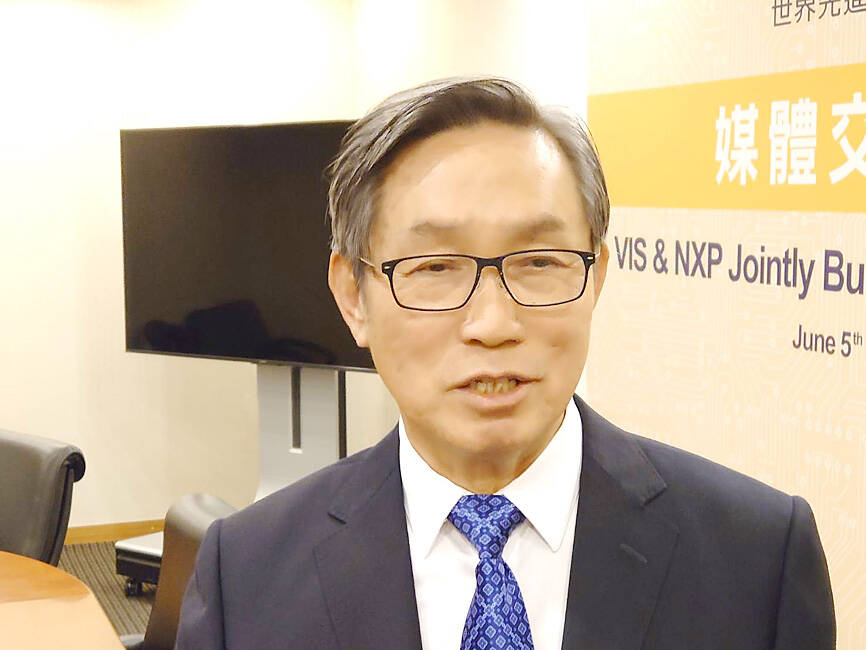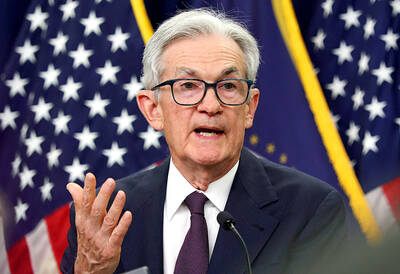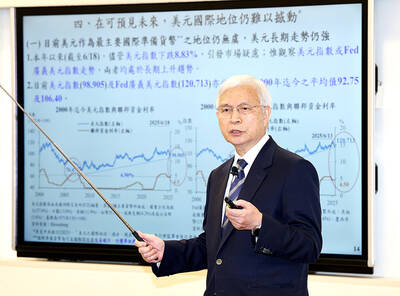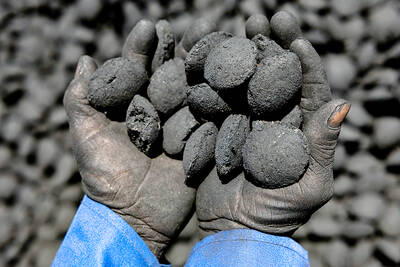Contract chipmaker Vanguard International Semiconductor Corp (世界先進) yesterday posted its strongest profit in three quarters last quarter, but said wafer shipments are expected to dip more than 10 percent sequentially this quarter as customers entered a year-end inventory adjustment cycle.
Net profit last quarter surged 31.4 percent annually, or 18.6 percent sequentially, to NT$2.13 billion (US$66.63 million), thanks to a seasonal pickup in customers demand.
Earnings per share rose to NT$1.29 from NT$0.98 in the same period last year and NT$1.09 in the second quarter.

Photo: CNA
Vanguard expects wafer shipments to slide between 10 percent and 12 percent quarter-on-quarter.
The chipmaker also expects inventory adjustments — likely to extend into the first quarter of next year — to crimp demand for chips used in vehicles and industrial devices.
“Currently, the company has order visibility of two to three months,” Vanguard president John Wei (尉濟時) told investors yesterday.
Photo: Grace Hung, Taipei Times
Its factory utilization rate is expected to drop to about 65 percent this quarter from 73 percent last quarter, while gross margin is estimated to range from 27 percent to 29 percent, compared with 29 percent in the second quarter, the company said.
The company’s blended average selling prices are projected to rise 3 percent to 5 percent this quarter from last quarter, thanks to stronger demand for higher-price power management ICs, offsetting sluggish demand for driver ICs used in flat panel displays, it said.
Power management ICs contributed 66 percent of the chipmaker’s revenue last quarter, while display driver ICs accounted for about 31 percent, company data showed.
Vanguard said it expects to recognize additional income from long-term-agreement customers this quarter following terms renegotiations, which would approximately make up 3 percent to 4 percent of the quarter’s revenue.
The company yesterday raised its capital expenditure for this year again to about NT$5 billion, from an earlier estimate of NT$4.5 billion, due to related spending for the construction of its first 12-inch fab in Singapore through a joint venture, VisionPower Semiconductor Manufacturing Co Pte Ltd (VSMC), with NXP Semiconductor NV.
Its board of directors on Monday approved NT$24.12 billion equipment and facilities expenditures for VSMC and NT$1.18 billion for existing 8-inch fabs.
Despite the capital spending increases, the company aims to keep its cash dividend distribution unchanged at NT$4.5 per share for at least the next three years as it has accumulated significant distributable earnings, Vanguard chairman Fang Leuh (方略) said.

DIVIDED VIEWS: Although the Fed agreed on holding rates steady, some officials see no rate cuts for this year, while 10 policymakers foresee two or more cuts There are a lot of unknowns about the outlook for the economy and interest rates, but US Federal Reserve Chair Jerome Powell signaled at least one thing seems certain: Higher prices are coming. Fed policymakers voted unanimously to hold interest rates steady at a range of 4.25 percent to 4.50 percent for a fourth straight meeting on Wednesday, as they await clarity on whether tariffs would leave a one-time or more lasting mark on inflation. Powell said it is still unclear how much of the bill would fall on the shoulders of consumers, but he expects to learn more about tariffs

NOT JUSTIFIED: The bank’s governor said there would only be a rate cut if inflation falls below 1.5% and economic conditions deteriorate, which have not been detected The central bank yesterday kept its key interest rates unchanged for a fifth consecutive quarter, aligning with market expectations, while slightly lowering its inflation outlook amid signs of cooling price pressures. The move came after the US Federal Reserve held rates steady overnight, despite pressure from US President Donald Trump to cut borrowing costs. Central bank board members unanimously voted to maintain the discount rate at 2 percent, the secured loan rate at 2.375 percent and the overnight lending rate at 4.25 percent. “We consider the policy decision appropriate, although it suggests tightening leaning after factoring in slackening inflation and stable GDP growth,”

Meta Platforms Inc offered US$100 million bonuses to OpenAI employees in an unsuccessful bid to poach the ChatGPT maker’s talent and strengthen its own generative artificial intelligence (AI) teams, OpenAI CEO Sam Altman has said. Facebook’s parent company — a competitor of OpenAI — also offered “giant” annual salaries exceeding US$100 million to OpenAI staffers, Altman said in an interview on the Uncapped with Jack Altman podcast released on Tuesday. “It is crazy,” Sam Altman told his brother Jack in the interview. “I’m really happy that at least so far none of our best people have decided to take them

As they zigzagged from one machine to another in the searing African sun, the workers were covered in black soot. However, the charcoal they were making is known as “green,” and backers hope it can save impoverished Chad from rampant deforestation. Chad, a vast, landlocked country of 19 million people perched at the crossroads of north and central Africa, is steadily turning to desert. It has lost more than 90 percent of its forest cover since the 1970s, hit by climate change and overexploitation of trees for household uses such as cooking, officials say. “Green charcoal” aims to protect what